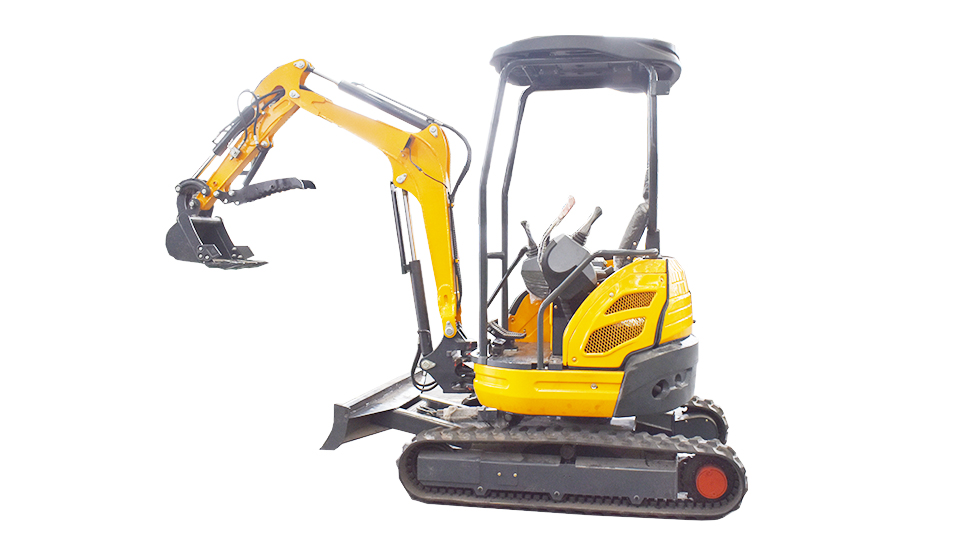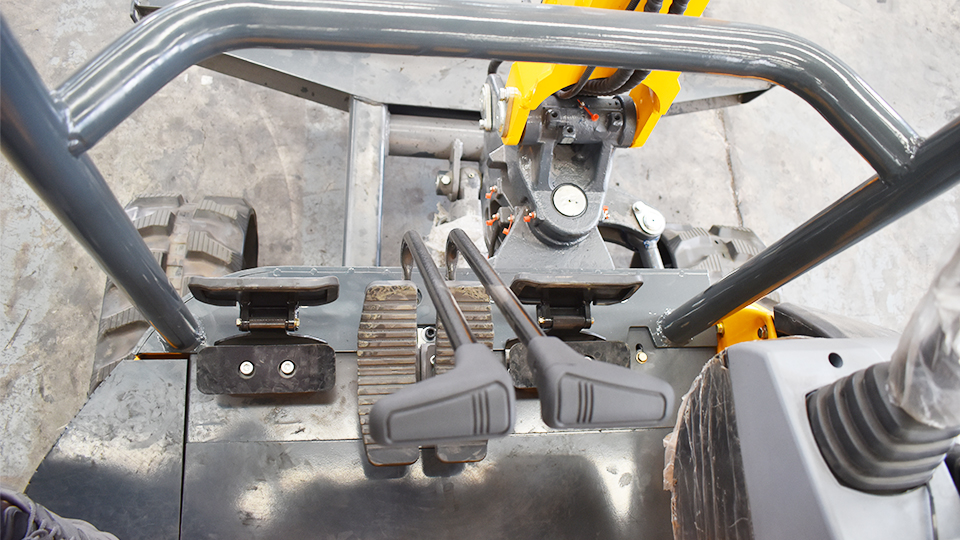In the highly competitive world of construction and mining, where profit margins are often measured in fractions of a percent, the cost of fuel is a constant and significant concern. For heavy machinery like hydraulic excavators, which can consume a substantial amount of diesel fuel, optimizing fuel efficiency is not just a matter of saving money—it's a critical factor in a business's long-term profitability and its environmental footprint.
Komatsu, a global leader in heavy equipment manufacturing, has made fuel efficiency a cornerstone of its excavator design philosophy. We will explore how their engineering and technological innovations work together to deliver impressive productivity while keeping fuel consumption in check.
The Holistic Approach to Fuel Efficiency
Komatsu's approach to fuel efficiency is not focused on a single component but rather on a holistic integration of advanced technologies across the entire machine. This strategy includes sophisticated engine design, intelligent hydraulic systems, and advanced operator-assist features, all of which are managed by a centralized electronic control system.

1. Advanced Engine Technology
The engine is the heart of any excavator, and its efficiency is paramount to the machine's overall fuel consumption. Komatsu's engines are not simply off-the-shelf powerplants; they are specifically designed and tuned for the demands of heavy equipment.
Tier 4 Final/Stage V Engines: In response to increasingly strict global emissions standards, Komatsu has developed a new generation of engines that are not only cleaner but also more fuel-efficient. These engines use a combination of technologies to reduce pollutants and optimize combustion.
High-Pressure Common Rail (HPCR) System: This system precisely controls the timing, pressure, and quantity of fuel injected into the combustion chamber. By atomizing the fuel into a fine mist and delivering it at high pressure, the HPCR system ensures a more complete and efficient burn, which directly translates to lower fuel consumption and reduced emissions.
Variable Geometry Turbocharger (VGT): The VGT system optimizes the airflow into the engine under all speed and load conditions. By adjusting the turbocharger's geometry, it ensures the engine receives the ideal amount of air for combustion, improving efficiency and performance.
EGR (Exhaust Gas Recirculation) System: The cooled EGR system is a well-proven technology that recirculates a portion of the exhaust gas back into the combustion chamber. This reduces the combustion temperature, which in turn lowers the formation of nitrogen oxides (NOx) and contributes to better fuel economy.
After-treatment Systems: Komatsu's Tier 4 Final and Stage V engines use a robust after-treatment system, which often includes a Diesel Particulate Filter (DPF) and Selective Catalytic Reduction (SCR). While these systems are primarily for emissions control, their efficient operation is a key part of the engine's overall design, allowing the engine to run at its most efficient point.
2. Intelligent Hydraulic Systems
The hydraulic system is what gives an excavator its power. However, in older or less-advanced machines, the hydraulic system can be a major source of energy loss. Komatsu's hydraulic systems are engineered to minimize this loss, ensuring that every bit of power generated by the engine is used efficiently to move the bucket, arm, and boom.
HydrauMind System: This advanced system, a Komatsu patented technology, electronically manages the hydraulic system to optimize the flow of oil to the various components. It provides seamless control and ensures that hydraulic power is distributed efficiently, preventing unnecessary energy wastage. This system is designed to make the machine feel like a natural extension of the operator, allowing for precise and powerful movements with less fuel consumption.
Total Power Control: This feature ensures that all hydraulic components work in perfect sync, optimizing energy utilization. For example, when the machine is under a light load, the system reduces the engine speed and hydraulic flow to save fuel. When the operator needs more power, the system seamlessly and instantly provides it, without the need to manually switch modes.
Komatsu Hybrid Technology: The company was a pioneer in hybrid excavators, introducing the first such machine in 2008. The Komatsu Hybrid System uses an electric swing motor/generator and an ultra-capacitor. The system captures the kinetic energy generated during the swing braking process, stores it in the ultra-capacitor, and then reuses it to assist the engine when the machine begins its next swing cycle. This groundbreaking technology can reduce fuel consumption by a significant margin—in some cases, up to 40%—while also reducing emissions.
3. Operator-Centric Fuel-Saving Features
While advanced engineering is crucial, the operator's habits and choices also play a significant role in fuel efficiency. Komatsu's excavators are equipped with features that empower operators to make more fuel-conscious decisions.
Work Modes: Komatsu excavators come with multiple selectable work modes that allow the operator to match the machine's performance to the task at hand.
P (Power) Mode: This mode prioritizes maximum productivity, delivering full engine power for heavy-duty applications like deep digging in hard material.

E (Economy) Mode: This is the go-to mode for tasks that don't require maximum power, such as light digging, grading, or loading trucks. It reduces engine speed and hydraulic pressure to provide a substantial fuel savings (often 10-20%) without a significant loss in productivity for the right application.
L (Lifting) Mode: This mode is specifically designed for lifting heavy loads, adjusting hydraulic pressure and speed to ensure safe and stable operation.
Breaker Mode: This mode optimizes engine speed and hydraulic flow for use with a hydraulic breaker, ensuring efficient and effective operation of the attachment.
Auto Idle Shutdown (AIS): A significant portion of an excavator's fuel is consumed during idle time. The Auto Idle Shutdown feature automatically turns off the engine after a pre-set period of inactivity (typically 5 minutes). This simple yet effective feature prevents unnecessary fuel wastage and is a major contributor to a lower idle ratio.
Eco-Gauge and Eco Guidance: Many Komatsu excavators are equipped with a monitor that provides real-time feedback to the operator on their fuel consumption. The Eco-Gauge displays the current fuel efficiency, encouraging the operator to keep the machine's operation in the "green" range. The Eco Guidance function provides helpful tips and warnings, such as notifying the operator if the machine has been idling for too long or if a more fuel-efficient work mode could be used.
4. Telematics and Fleet Management: The KOMTRAX System
Komatsu's telematics system, KOMTRAX, is a powerful tool for fleet owners and managers to monitor and optimize fuel efficiency. KOMTRAX provides a wealth of data on machine health, location, and operational metrics.
Fuel Consumption Reports: KOMTRAX provides detailed reports on a machine's fuel consumption, allowing managers to track usage over time, compare it to other machines in the fleet, and identify areas for improvement.
Idle Time Monitoring: The system tracks the exact amount of time a machine spends idling. This data is invaluable for identifying operators who may need additional training on idle management.
Operational Data: KOMTRAX also provides data on how the machine is being used, such as the percentage of time spent in Power vs. Economy mode. This allows managers to ensure that operators are using the correct work mode for the task at hand.
Maintenance Alerts: KOMTRAX can send alerts for upcoming maintenance needs. A well-maintained machine is a fuel-efficient machine, as clogged air filters, old oil, and faulty hydraulic systems can all lead to increased fuel consumption. By using KOMTRAX to stay on top of maintenance, fleet managers can ensure their machines are always running at peak efficiency.
Operational Best Practices for Maximizing Fuel Efficiency
Even with Komatsu's advanced technology, the operator's skill and attention to detail are crucial. Here are some operational best practices that, when combined with the machine's features, can lead to significant fuel savings:
Match the Machine to the Job: Using an appropriately sized excavator for the task at hand is the first and most important step. A large machine on a small job will consume more fuel than necessary, while a small machine on a large job will overexert and burn more fuel to get the job done.
Minimize Idling: This is arguably the easiest and most impactful way to save fuel. Operators should be trained to use the Auto Idle Shutdown feature and to turn off the engine during extended breaks or delays.
Use the Correct Work Mode: Operators should be trained to use Economy mode whenever possible, switching to Power mode only when the task truly demands it.
Smooth Operation: Aggressive, jerky movements consume more fuel than smooth, deliberate movements. Operators who are skilled at their trade can achieve the same level of productivity with less fuel by being more fluid and precise in their operation.
Digging Technique: Operators should be trained to use the digging and breakout force of the machine efficiently. By using the bucket curl and arm crowd together, they can fill the bucket with less effort and less fuel.
Conclusion: A Commitment to Efficiency
Komatsu's commitment to fuel efficiency is evident in every aspect of their excavator design, from the advanced Tier 4 Final engines and intelligent hydraulic systems to the operator-friendly work modes and the data-rich KOMTRAX telematics system. They understand that in today's market, a machine's value is not just measured by its raw power, but also by its ability to deliver that power in the most cost-effective and environmentally friendly way possible.
The fuel efficiency of a Komatsu excavator is a function of its sophisticated engineering, the informed choices of the operator, and a comprehensive fleet management strategy. By leveraging the advanced technologies built into the machines and adopting smart operational practices, businesses can achieve a powerful combination of high productivity, low operating costs, and reduced environmental impact. In an industry where every liter of fuel matters, Komatsu provides the tools and technology to make a significant difference.
Post time:Sep-25-2020
